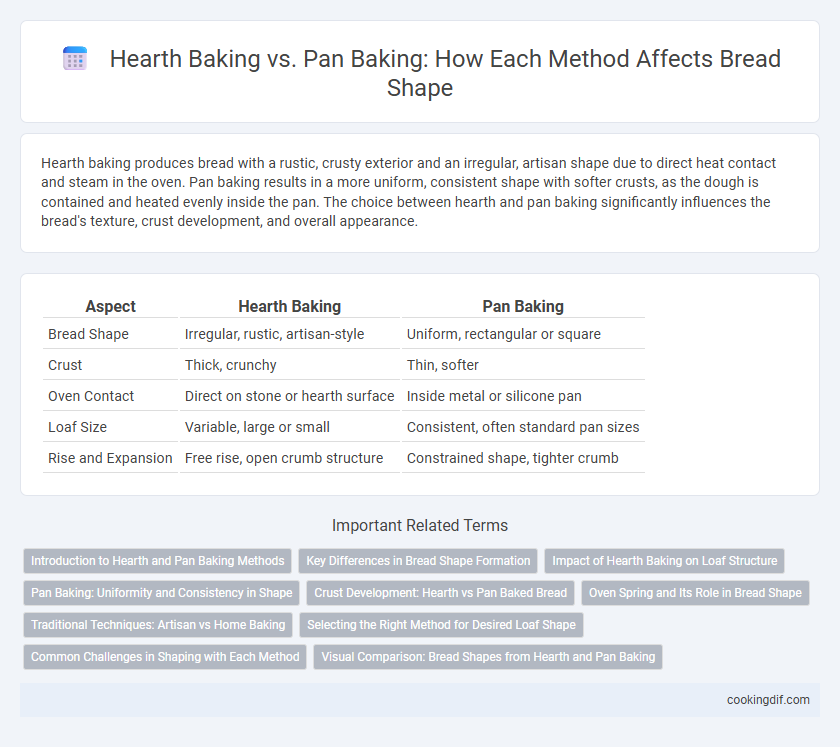Hearth baking produces bread with a rustic, crusty exterior and an irregular, artisan shape due to direct heat contact and steam in the oven. Pan baking results in a more uniform, consistent shape with softer crusts, as the dough is contained and heated evenly inside the pan. The choice between hearth and pan baking significantly influences the bread's texture, crust development, and overall appearance.
Table of Comparison
| Aspect | Hearth Baking | Pan Baking |
|---|---|---|
| Bread Shape | Irregular, rustic, artisan-style | Uniform, rectangular or square |
| Crust | Thick, crunchy | Thin, softer |
| Oven Contact | Direct on stone or hearth surface | Inside metal or silicone pan |
| Loaf Size | Variable, large or small | Consistent, often standard pan sizes |
| Rise and Expansion | Free rise, open crumb structure | Constrained shape, tighter crumb |
Introduction to Hearth and Pan Baking Methods
Hearth baking involves placing the dough directly on a hot surface, producing a crusty, rustic loaf with an uneven, artisanal shape, while pan baking uses a container to give bread a uniform, consistent form with a softer crust. The intense, dry heat of the hearth encourages better oven spring and a chewy texture, contrasting with the controlled environment of pan baking that limits crust development. Choosing between hearth and pan methods depends on the desired bread shape, crust texture, and overall baking style.
Key Differences in Bread Shape Formation
Hearth baking produces bread with a thick, crusty exterior and an irregular, rustic shape due to direct contact with intense heat on a stone or brick surface. Pan baking, using a confined mold, results in uniform, rectangular loaves with a softer crust and even crumb structure. The primary difference in bread shape formation lies in the unrestricted expansion during hearth baking versus the controlled rise within the pan's rigid boundaries.
Impact of Hearth Baking on Loaf Structure
Hearth baking produces a thicker, crispier crust and a more open crumb structure due to the intense, direct heat from the stone surface, which promotes better oven spring and improved gas retention within the dough. The radiant heat from the hearth encourages even expansion and caramelization of sugars, resulting in enhanced flavor complexity and a rustic, artisanal appearance. This method typically yields a loaf with a rounded, domed shape and irregular air pockets, distinguishing it from the denser, more uniform structure seen in pan-baked bread.
Pan Baking: Uniformity and Consistency in Shape
Pan baking produces bread with greater uniformity and consistency in shape due to the confined structure of the pan, which supports the dough evenly during the baking process. This method results in loaves with predictable dimensions, ideal for slicing and sandwich making. In contrast, hearth baking allows more freedom in expansion, often leading to rustic, irregular shapes but less uniformity in size.
Crust Development: Hearth vs Pan Baked Bread
Hearth baking produces a thicker, crispier crust due to direct exposure to high heat and open flames, which promotes intense caramelization and Maillard reactions. Pan baking results in a softer, thinner crust because the dough is insulated from direct heat by the baking vessel, retaining more moisture during baking. Crust development in hearth-baked bread enhances flavor complexity and texture, while pan-baked bread offers more uniform crumb structure with a tender crust.
Oven Spring and Its Role in Bread Shape
Hearth baking produces superior oven spring due to direct contact with the hot baking surface, resulting in better heat transfer and more vigorous gas expansion within the dough. This method promotes a rounder, more open crumb structure and a crust with enhanced caramelization. Pan baking limits oven spring as the dough is confined, leading to a uniform, rectangular shape with a denser texture and less pronounced crust development.
Traditional Techniques: Artisan vs Home Baking
Hearth baking produces a rustic, crusty loaf with an open crumb, characteristic of traditional artisan bread made in stone or brick ovens, emphasizing natural heat retention and steam generation. Pan baking, common in home baking, yields a uniform shape with softer crusts, using enclosed metal pans that limit crust development but provide consistent heat distribution. Artisan hearth baking prioritizes flavor and texture through ancient techniques, while home pan baking focuses on convenience and reproducibility.
Selecting the Right Method for Desired Loaf Shape
Hearth baking produces crusty, round loaves with open crumb structures by exposing dough directly to radiant heat on a hot surface, ideal for artisan-style bread. Pan baking confines dough in a mold, resulting in uniform, rectangular loaves with tighter crumb suitable for sandwich bread. Selecting the right method depends on whether a rustic, free-form shape or a consistent, structured loaf is desired.
Common Challenges in Shaping with Each Method
Hearth baking often produces rustic, irregularly shaped loaves due to the direct contact with the oven floor, which can cause uneven heat distribution and difficulty maintaining dough structure. Pan baking offers more uniform shapes and controlled expansion, but common challenges include dough sticking to the pan and limited crust development. Mastering dough hydration and proper proofing times are essential to overcome shaping issues in both methods.
Visual Comparison: Bread Shapes from Hearth and Pan Baking
Hearth baking produces bread with a rustic, irregular crust and a more artisanal, free-form shape due to direct contact with the oven surface. Pan baking results in loaves with uniform, defined edges and a consistent height because the dough is confined within the pan shape. Visual comparison highlights hearth bread's round, open appearance versus pan bread's structured, rectangular loaf form.
Hearth Baking vs Pan Baking for bread shape Infographic

 cookingdif.com
cookingdif.com